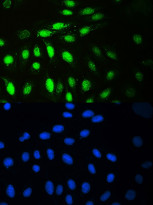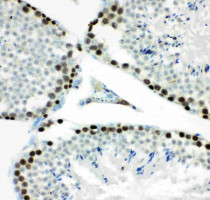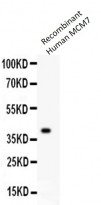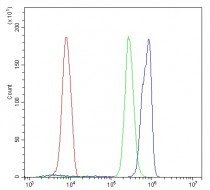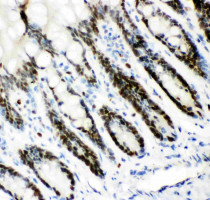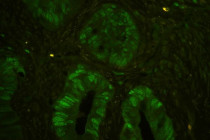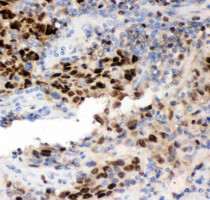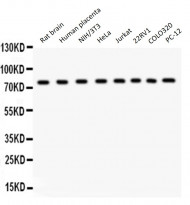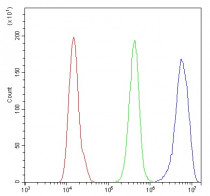ARG59031
anti-MCM7 antibody
anti-MCM7 antibody for Flow cytometry,ICC/IF,IHC-Formalin-fixed paraffin-embedded sections,Western blot and Human,Mouse,Rat
概述
| 产品描述 | Rabbit Polyclonal antibody recognizes MCM7 |
|---|---|
| 反应物种 | Hu, Ms, Rat |
| 应用 | FACS, ICC/IF, IHC-P, WB |
| 宿主 | Rabbit |
| 克隆 | Polyclonal |
| 同位型 | IgG |
| 靶点名称 | MCM7 |
| 抗原物种 | Human |
| 抗原 | Recombinant protein corresponding to D526-V719 of Human MCM7. |
| 偶联标记 | Un-conjugated |
| 別名 | PNAS146; CDC47 homolog; DNA replication licensing factor MCM7; MCM2; P1.1-MCM3; EC 3.6.4.12; CDC47; P1CDC47; P85MCM; PPP1R104 |
应用说明
| 应用建议 |
|
||||||||||
|---|---|---|---|---|---|---|---|---|---|---|---|
| 应用说明 | IHC-P: Antigen Retrieval: Heat mediation was performed in Citrate buffer (pH 6.0) for 20 min. * The dilutions indicate recommended starting dilutions and the optimal dilutions or concentrations should be determined by the scientist. |
属性
| 形式 | Liquid |
|---|---|
| 纯化 | Affinity purification with immunogen. |
| 缓冲液 | 0.2% Na2HPO4, 0.9% NaCl, 0.05% Sodium azide and 5% BSA. |
| 抗菌剂 | 0.05% Sodium azide |
| 稳定剂 | 5% BSA |
| 浓度 | 0.5 mg/ml |
| 存放说明 | For continuous use, store undiluted antibody at 2-8°C for up to a week. For long-term storage, aliquot and store at -20°C or below. Storage in frost free freezers is not recommended. Avoid repeated freeze/thaw cycles. Suggest spin the vial prior to opening. The antibody solution should be gently mixed before use. |
| 注意事项 | For laboratory research only, not for drug, diagnostic or other use. |
生物信息
| 数据库连接 |
Swiss-port # P33993 Human DNA replication licensing factor MCM7 Swiss-port # Q61881 Mouse DNA replication licensing factor MCM7 |
|---|---|
| 基因名称 | MCM7 |
| 全名 | minichromosome maintenance complex component 7 |
| 背景介绍 | The protein encoded by this gene is one of the highly conserved mini-chromosome maintenance proteins (MCM) that are essential for the initiation of eukaryotic genome replication. The hexameric protein complex formed by the MCM proteins is a key component of the pre-replication complex (pre_RC) and may be involved in the formation of replication forks and in the recruitment of other DNA replication related proteins. The MCM complex consisting of this protein and MCM2, 4 and 6 proteins possesses DNA helicase activity, and may act as a DNA unwinding enzyme. Cyclin D1-dependent kinase, CDK4, is found to associate with this protein, and may regulate the binding of this protein with the tumorsuppressor protein RB1/RB. Alternatively spliced transcript variants encoding distinct isoforms have been reported. [provided by RefSeq, Jul 2008] |
| 生物功能 | Acts as component of the MCM2-7 complex (MCM complex) which is the putative replicative helicase essential for 'once per cell cycle' DNA replication initiation and elongation in eukaryotic cells. The active ATPase sites in the MCM2-7 ring are formed through the interaction surfaces of two neighboring subunits such that a critical structure of a conserved arginine finger motif is provided in trans relative to the ATP-binding site of the Walker A box of the adjacent subunit. The six ATPase active sites, however, are likely to contribute differentially to the complex helicase activity. Required for S-phase checkpoint activation upon UV-induced damage. [UniProt] |
| 细胞定位 | Nucleus. [UniProt] |
| 预测分子量 | 81 kDa |
| 翻译后修饰 | O-glycosylated (O-GlcNAcylated), in a cell cycle-dependent manner. [UniProt] |
检测图片 (11) Click the Picture to Zoom In
-
ARG59031 anti-MCM7 antibody ICC image
Immunocytochemistry: A549 cells stained with ARG59031 anti-MCM7 antibody.
-
ARG59031 anti-MCM7 antibody ICC/IF image
Immunofluorescence: U2OS cells were blocked with 10% goat serum and then stained with ARG59031 anti-MCM7 antibody (green) at 2 µg/ml dilution, overnight at 4°C. DAPI (blue) for nuclear staining.
-
ARG59031 anti-MCM7 antibody IHC-P image
Immunohistochemistry: Paraffin-embedded Mouse testis tissue stained with ARG59031 anti-MCM7 antibody.
-
ARG59031 anti-MCM7 antibody IHC-P image
Immunohistochemistry: Paraffin-embedded Human colon cancer tissue. Antigen Retrieval: Heat mediation was performed in Citrate buffer (pH 6.0) for 20 min. The tissue section was blocked with 10% goat serum. The tissue section was then stained with ARG59031 anti-MCM7 antibody (red) at 2 µg/ml dilution, overnight at 4°C.
-
ARG59031 anti-MCM7 antibody WB image
Western blot: 0.5 ng of Recombinant Human MCM7 Protein stained with ARG59031 anti-MCM7 antibody at 0.5 µg/ml.
-
ARG59031 anti-MCM7 antibody FACS image
Flow Cytometry: U937 cells were blocked with 10% normal goat serum and then stained with ARG59031 anti-MCM7 antibody (blue) at 1 µg/10^6 cells for 30 min at 20°C, followed by incubation with DyLight®488 labelled secondary antibody. Isotype control antibody (green) was rabbit IgG (1 µg/10^6 cells) used under the same conditions. Unlabelled sample (red) was also used as a control.
-
ARG59031 anti-MCM7 antibody IHC-P image
Immunohistochemistry: Paraffin-embedded Rat intestine tissue stained with ARG59031 anti-MCM7 antibody.
-
ARG59031 anti-MCM7 antibody IHC-P image
Immunohistochemistry: Paraffin-embedded Human colon cancer tissue. Antigen Retrieval: Heat mediation was performed in Citrate buffer (pH 6.0) for 20 min. The tissue section was blocked with 10% goat serum. The tissue section was then stained with ARG59031 anti-MCM7 antibody (green) at 2 µg/ml dilution, overnight at 4°C.
-
ARG59031 anti-MCM7 antibody IHC-P image
Immunohistochemistry: Paraffin-embedded Human lung cancer tissue stained with ARG59031 anti-MCM7 antibody.
-
ARG59031 anti-MCM7 antibody WB image
Western blot: 50 µg of Rat brain, 50 µg of Human placenta, 40 µg of NIH/3T3, 40 µg of HeLa, 40 µg of Jurkat, 40 µg of 22RV1, 40 µg of COLO320 and 40 µg of PC-12 lysates stained with ARG59031 anti-MCM7 antibody at 0.5 µg/ml dilution.
-
ARG59031 anti-MCM7 antibody FACS image
Flow Cytometry: A431 cells were blocked with 10% normal goat serum and then stained with ARG59031 anti-MCM7 antibody (blue) at 1 µg/10^6 cells for 30 min at 20°C, followed by incubation with DyLight®488 labelled secondary antibody. Isotype control antibody (green) was rabbit IgG (1 µg/10^6 cells) used under the same conditions. Unlabelled sample (red) was also used as a control.

